Christian Mindfulness Ideas for Kids
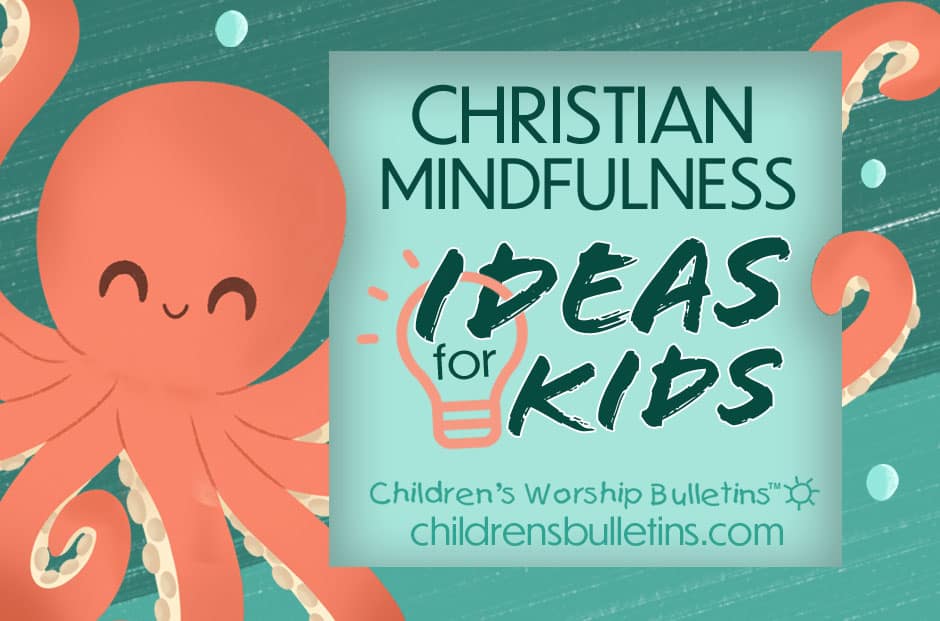
Over the past few years, stress levels in homes, classrooms, and church programs have risen noticeably. Research from the American Psychological Association shows that parents and young people shoulder a heavy share of that anxiety, which can trigger behavioral changes and even long-term health risks. Teaching kids—both big and small—simple, physical Christian mindfulness activities equips them with a lifelong tool kit for managing emotions such as worry and fear.
Teaching kids (big and small) to put achievable, physical actions to help manage and cope with anxiety, worry and fear is a great life skill to know when it comes to coping with emotions.
While mindfulness may be considered New Age, several Bible verses encourage meditation on God’s Word. Mindfulness, meaning increasing the moment’s awareness of one’s presence, is different from meditation. It is a way to help oneself “be still” so that you can fully engage with God through prayer or His word.
Below, we’ve listed 4 of the most common practices for grounding and self-regulation (i.e., the bringing of oneself into a state of order) and taken each of them a step further to connect them to God and Scripture. This creates encouraging Christian mindfulness ideas you can use with your kids at home or church.
- Method 1: Box Breathing
- Method 2: Orient Yourself
- Method 3: Repetitive Affirmation
- Method 4: Throw Stress Away
- Free Mindfulness Activity Cards
Method 1: Box Breathing.
What is Box Breathing?
This is by far our favorite guided mindfulness or grounding practice we like to do with kids. Although it is often used in meditation, it is a simple exercise that can take less than 10 minutes and can easily be connected back to God’s Word.
Box breathing is a great way to help children regulate their bodies by focusing on their breathing. Adults can also receive benefits from these techniques. It is also a technique often taught to first responders. This meditation and relaxation technique is also referred to as Square Breathing or 4 Square Breaths.
Steps to Box Breathing.
For kids, to begin Box Breathing, it is best to have them stand upright, still and towards you. This allows them to get big, deep breaths. Adults may find sitting or lying down on the floor more comfortable.
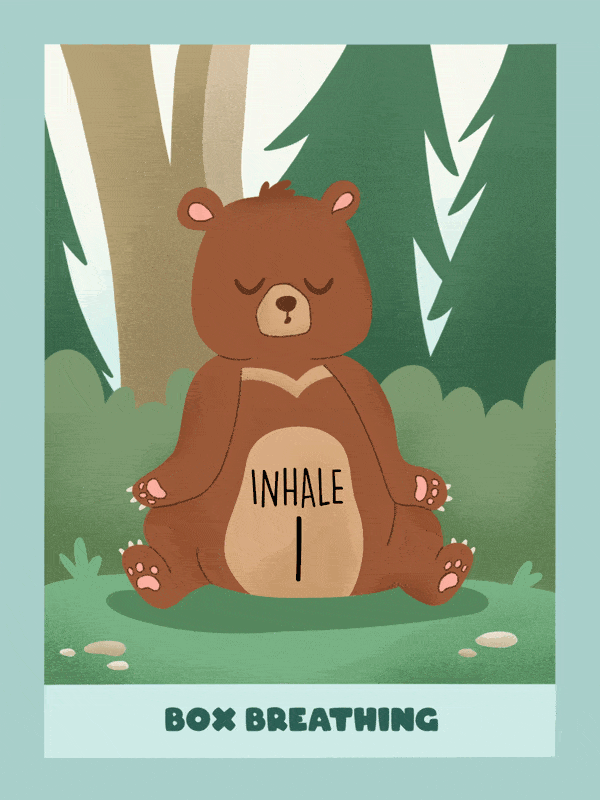
Once a child is still as possible, begin with slow inhaling through your nose to the count of four. Guide children that they are trying to fill up their lungs completely full of air.
Then hold your breath to a count of four.
Next, exhale through your mouth for the same count of four. Again, instructing children that they are trying to get all the air out of our lungs.
Hold your breath again for the same count of four. Repeat the process as many times as needed.
For children who are very worked up, your counts of four can be quick and then each time you repeat the steps, you can slow down your counts. Adapt for children to be sure they don’t get dizzy during the holds.
Ideally, you would like to do at least 4 cycles or rounds of square breathing in one sitting (meaning inhale, hold, exhale, hold 4 consecutive times), but children may need to do this more if the first rounds are not completed.
Box Breathing has been proven to calm nerves, relieve stress and help with concentration.
Bringing it to God: Prayer or Scripture to repeat at the end of the exercise.
Once a child has completed the mindfulness exercise, it’s great to close the session with a prayer or Scripture before moving on or returning to the activity the child was engaged in.
Don’t be afraid to use a prayer that is scripted or written down on a card, short and simple. Too lengthy of a prayer may feel disconnected rather than part of the routine to help self-regulate.
Here is an example of a prayer we use with our kids:
“God, thank you for giving me the Breath of Life. Thank you for the oxygen to fill my lungs and how it helps me, other people, the birds and animals, flowers and trees grow and feel better. Thank you for being there when I feel stressed. Help me to always remember You and ways to be calm during those times. In Jesus’ Name, Amen.”
If this is a mindful breathing exercise you want to incorporate into your everyday life with your children, you may want to consider incorporating this into your bedtime routine and then close with your daily prayer.
If you would rather repeat Scripture, here is an example Bible verse you can also write down to repeat at the end if you prefer over a prayer:
“Let everything that has breath praise the Lord. Praise the Lord.” Psalm 150:6, NIV
Method 2: Orient yourself in time and space.
What is orienting yourself in time and space?
This grounding practice is most successful with those suffering from anxiety or feeling overwhelmed. This five-step practice helps to refocus one’s brain on the present and to slow down your brain thoughts which can help lower anxiety and panic.
Your brain cannot do two things at once (even though we often think it can), so for children who may be suffering from anxiety or coming close to panicking in a situation, this exercise is perfect to focus the brain away from the thoughts that are causing the panic and calm the mind as the mind cannot panic and do this exercise at the same time.
Steps to orienting yourself.
First, with any mindfulness activity with kids, start with trying to find a quiet place and start with a deep, quiet breath or two.
Once you’ve found your space and breath, go through these 5 steps:
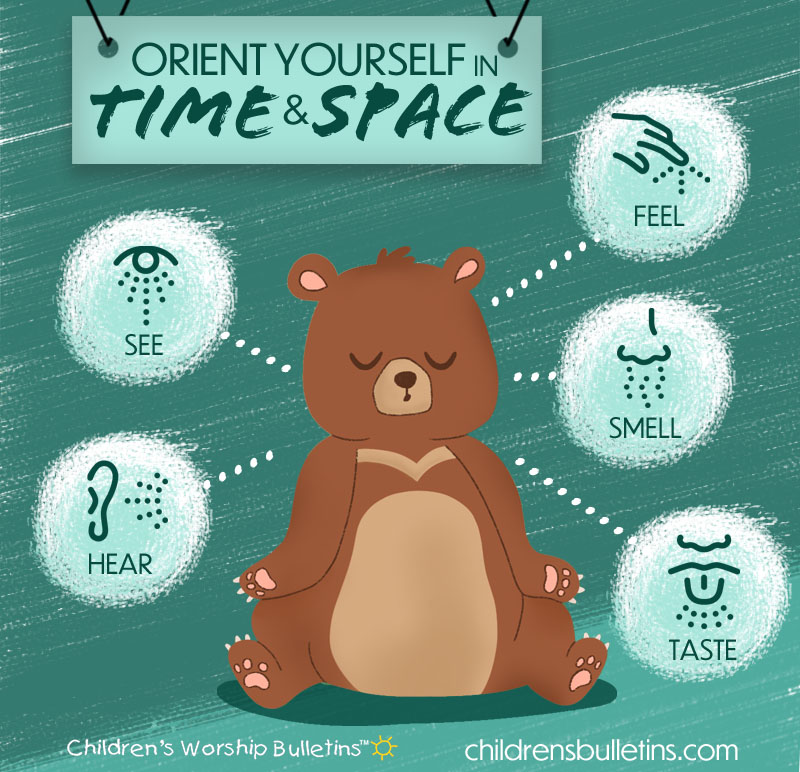
Step 1: Ask the child: “What are FIVE things you see around you?” You can guide them to examples such as an object, a crack on the floor, anything in your surroundings. Wait for the child to name 5 things, counting them on your fingers.
Step 2: Ask the child: “What are FOUR things you can feel?” Answers can be as simple as the ground under their feet, the clothes on their body, your hand holding theirs – anything they can touch or feel. Give ample time for the child to name 4 things, counting them on your fingers.
Step 3: Ask the child: “What are THREE things you can hear?” This can be an external or internal sound! If kids name things they hear inside their body, but you can’t hear, that counts. Wait for the child to name these sounds, counting them on your fingers.
Step 4: Ask the child: “What are TWO things you can smell?” This is always a fun one, because if the child is calming down, it can be an opportunity to connect, laugh and engage a little about strange or wonderful smells. Count these smells on your fingers.
Step 5: Ask the child: “What is ONE thing you can taste?” Essentially, what does their mouth taste like? Their lunch? Bad breath? Any answer is acceptable.
When doing this exercise, depending on your environment, you can rotate the difference sense for each step if you prefer. However, we find Smell and Taste are often best left for last.
Bringing it to God: Connecting senses to God’s Word.
After completing the mindful awareness activity, help connect the child’s answers to God’s Word. Ask them out of the things they saw, felt, heard, smelled, or tasted, do any of them remind them of any Bible verses or Bible stories? For example, if they heard water, did that remind them of Noah and the flood?
Use the opportunity to engage with your little one about God’s Word and apply Scripture to everyday surroundings.
If a child can’t think of anything, ask if you can give them a hug. Did they feel that hug? What did it feel like? Did you smell funny?
Connect that hug with a message about Jesus’ love for us and/or how God protects us with His loving arms.
Method 3: Come up with a repetitive affirmation.
What are repetitive affirmations?
Affirmations are helpful catchphrases kids can repeat that are positive in nature that redirect the mind to positive action. By repeating these affirmations or phrases, one’s motivation and confidence is boosted to then be able to take a positive step or action.
The affirmations themselves do not create the change, but they are like little cheerleaders to help a child overcome the negative emotion and move past it.
Steps for using repetitive affirmations in a mindfulness exercise:
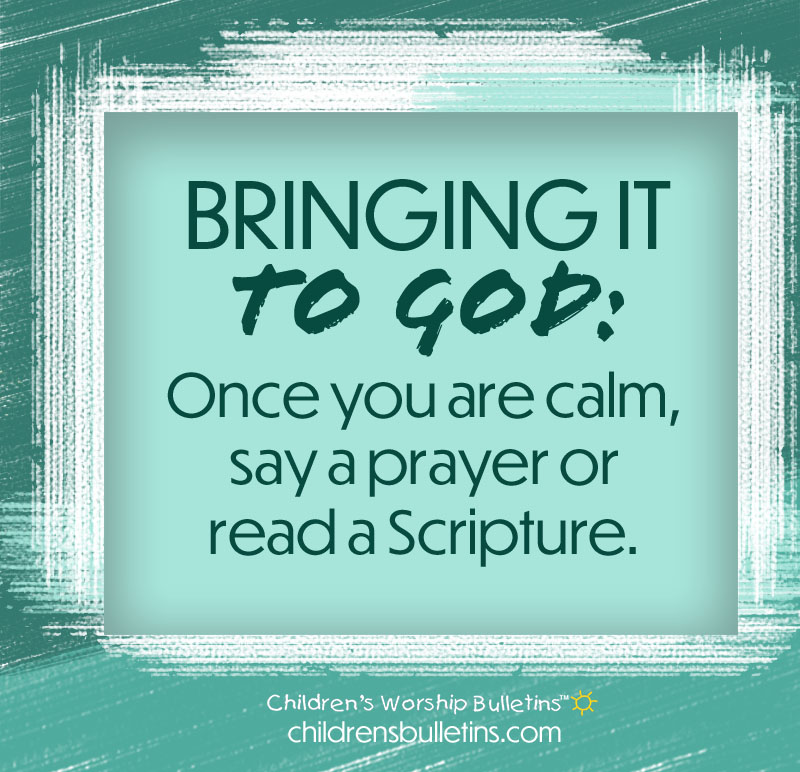
This activity is simple: Repeat the affirmation until you are feeling calm and confident to move forward.
A common example of an affirmation to repeat would be:
- I am uncomfortable, but I am safe.
- I am calm, I am happy, today will be a fun and happy day!
- I am thankful.
Kids can repeat the phrase to you out loud (most common) or read from a card out loud or even write while reading out loud if that is their learning style.
Bringing it to God: Using Scripture-based affirmations.
Here are five affirmations you can use with kids of all ages based on Scripture passages from the Bible:
- I am scared, but God goes before me. (Thought taken from Deuteronomy 31 & Isaiah 41)
- I feel lonely, but God is always with me. (From Psalm 23)
- I feel bullied, but God always loves me. (From Psalm 69:13)
- I feel small, but God is bigger and will protect me. (From 2 Thessalonians 3: 3)
- I feel like no one hears me, but God is always listening. (From 1 Peter 3:12)
Method 4: Throwing stress away.
What is throwing stress away?
This mindfulness activity is a great physical activity that helps kids regulate their bodies. It is also a technique that is great to use with more than one child at a time (just be sure there is plenty of space between the kids before you begin).
This physical activity helps the child/children visualize throwing away their stress and leaving it on the floor.
Steps to throwing away stress (or worry):
Stand with your arms above your head, fists clenched. Exhale forcefully while you throw your hands down towards the ground (but not touching the ground) and open your fingers. Throw the energy out of your body and into the ground.
Repeat as many times as needed.
Bringing it to God: Casting your anxieties upon the Lord:
We will all feel stressed and anxious from time to time. But what can we do about that? 1 Peter 5:7 NIV says: “Cast all your anxiety on [God] because he cares for you.”
After completing this activity, this is the perfect time to engage with kids about this Bible verse, what it means and how we can trust in God to lift us up in His time.
As an aside, there is a classic Arch Book (Jesus Teaches Us Not to Worry from Matthew 6:25-34) that has been a favorite of ours since we were children, and we read this book to our children today—it is a great story to read after this activity.
Guilding children through anxious times.
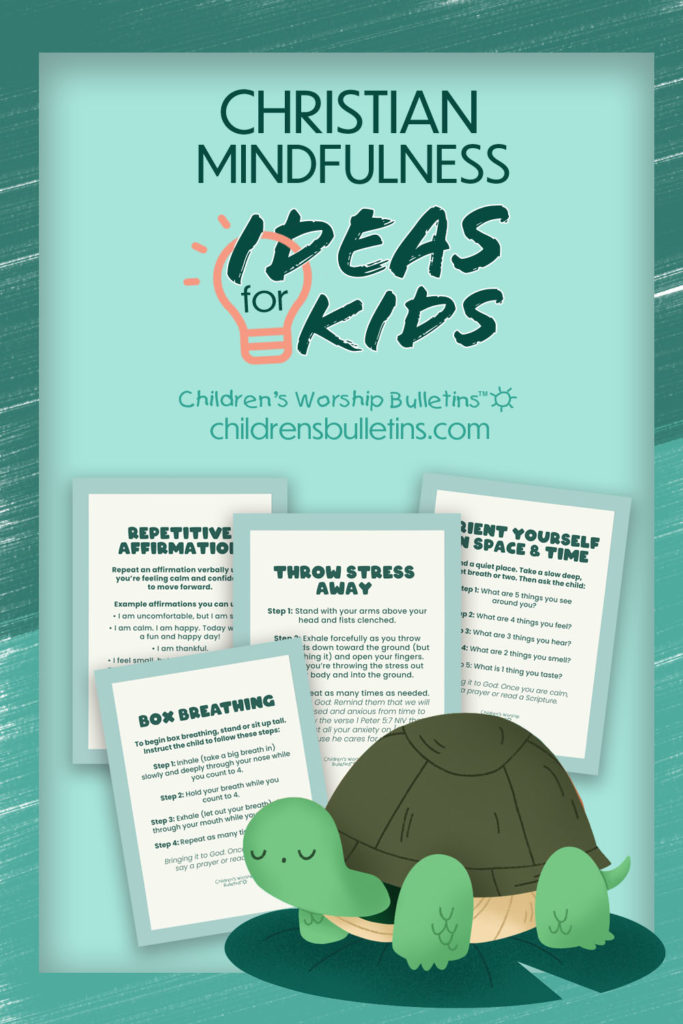
Although we’ve chosen our favorite four mindfulness exercises, there are many more proven methods to help relieve stress and worry for kids. Blowing bubbles, journaling, painting, or coloring are all great ways to engage with children to be present in the moment. Find the exercises and activities that work best for you!
Even if your children or children in your church may seem on the surface to be unfazed by big changes or don’t seem to have a problem dealing with big feelings or emotions, incorporating these techniques now can be powerful as children move through life.
As parents, teachers, and caregivers, it’s important that we teach children to take care of their physical and emotional well-being. Stress and anxiety will always exist in our world.
One of the best gifts we can give children is a set of practical techniques that help them regulate their minds whenever anxious moments arise and recenter their thoughts on God and His Word.
Download these FREE Christian Mindfulness Activity Cards
Click on the link below the download the PDF of the FREE Christian Mindfulness Ideas for Kids cards. Each illustrated, full-color card contains step-by-step instructions for each activity. Share this downloadable PDF with other parents and teachers.
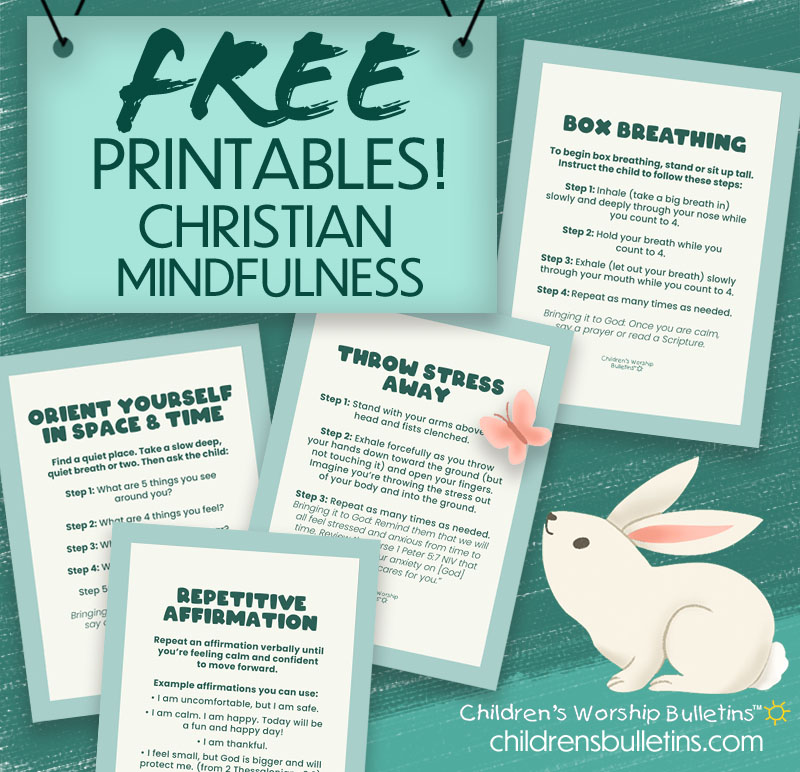
Download FREE Christian Mindfulness Ideas for Kids Cards PDF
Author Bio:
Children's Bulletins Team
Over the years of publication Children’s Worship Bulletins has had many contributing authors and editors. This team has worked diligently to thoughtfully craft material to assist in creating meaningful children’s worship materials.
